Chamberbitter Control: How to Get Rid of Gripeweed
Written by Iris
Oct 13 2021
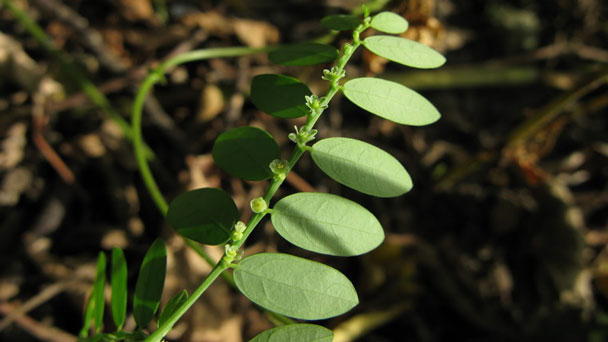
Chamberbitter is an annual herb with a height of several inches to a foot. The stem is purplish red, with small white flowers blooming along the bottom of the stem and leaves in summer and autumn, without stalk. After flowering, it bears oblate small fruits, shaped like small beads, arranged under the leaves. Chamberbitter florescence from April to June, fruiting period from July to November.
Chamberbitter looks very similar to the leaves of a mimosa tree and is a member of the spurge family. It goes to seed when it is only about an inch tall and the seeds are actually little balls that develop on the underside of the leaves.
Chamberbitter is a slender shrub with alternate leaves that are oblong to almost linear.
The stems often branch and can be reddish colored. When they have matured, Chamberbitter can develop a deep taproot which makes this weed particularly difficult to completely remove without the help of chemicals.
Use the above description and image to help you in properly identifying carpetweed. If you are having trouble, you can always contact us and our lawn care experts will help to correctly ID your weed growth and suggest treatment options.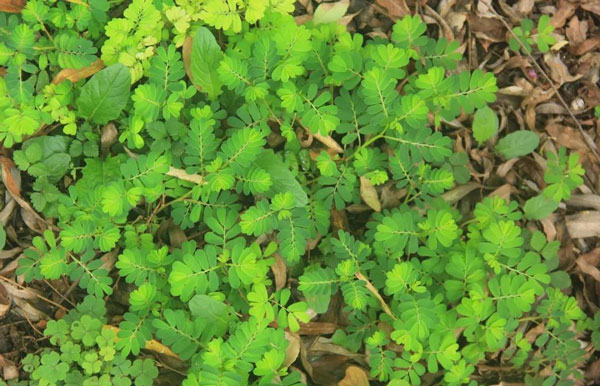
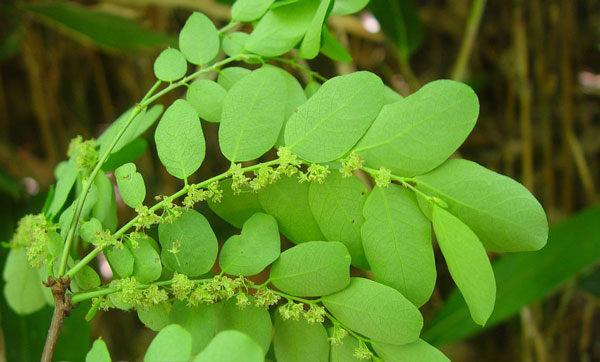
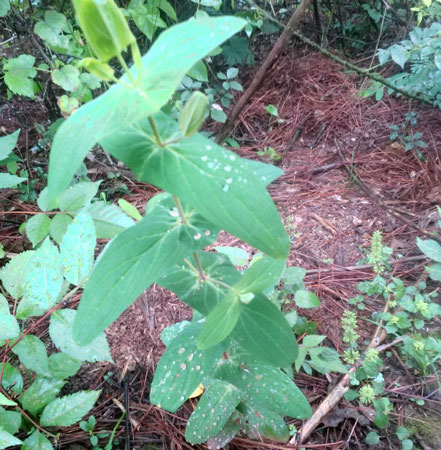
Atrazine is effective for preemergence control of chamberbitter in centipedegrass and in St. Augustinegrass lawns. Be careful not to apply on turf during the transition period from dormancy to active growth (spring green-up). Because chamberbitter tends to germinate in late spring and early summer (once the soil temperature reaches 70 °F), applications after grasses fully green up are effective. Target areas where chamberbitter was observed the previous season and be careful to not apply near the roots of desirable landscape plants.
Isoxaben is a preemergence herbicide that is effective for chamberbitter control in tall fescue, centipedegrass, St. Augustinegrass, bermudagrass, and zoysiagrass lawns. For home lawn use, it is purchased in a granular form, and the granules must be watered-in to allow the isoxaben to coat the soil surface for weed prevention. Make the first application in late spring and the second about 8 weeks later. See Table 1 for examples of products.
Isoxaben is also available as an additional active ingredient in one Bayer Advanced brand three-way herbicide. With this product, the postemergence, three-way, broadleaf weed control portion controls existing chamberbitter plants. The isoxaben portion will aid in preventing reinfestation of the area from seeds that may be present. To prevent new seeds from growing, the entire area to be protected must be sprayed. Wait 2 days after spray application and activate the isoxaben residual barrier by watering the lawn with ¼ to ½ inch of irrigation. Do not seed or overseed within 60 days after application. Do not apply isoxaben to a newly seeded lawn until it has been mowed 3 times.
On tall fescue, bermudagrass, and zoysiagrass lawns, repeat applications of three-way herbicides that contain 2,4-D, mecoprop (MCPP), and dicamba can be used to control chamberbitter. Apply these herbicides in late spring or early summer when the weeds are still young and space second application at 30 days later. These three-way herbicides may also be used on centipedegrass and St. Augustinegrass lawns at reduced rates and after the grasses have completely greened-up in the spring. Read the product labels for rates to mix and apply.
Celsius WG Herbicide, which contains thiencarbazone, iodosulfuron, and dicamba, will control chamberbitter, especially if applied when the average daily temperatures are over 60° F. Apply when chamberbitter is actively growing and again 2 to 4 weeks later, if needed. The addition of a non-ionic surfactant, such as Southern Ag Surfactant for Herbicides, will increase control.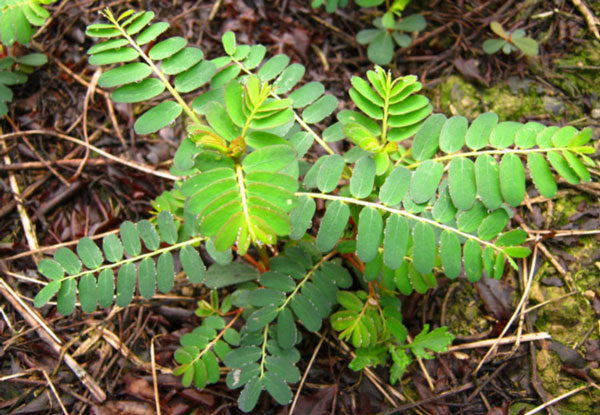
Glyphosate is a non-selective herbicide which can potentially damage any plant through contact with foliage or bark. Protect desirable plants from drift by not spraying in windy conditions, by keeping the spray nozzle close to the ground, and by using low pressure. Further protection is provided by attaching a plastic, cone shaped shield that surrounds the spray nozzle and confines the spray to the targeted plants. Shields can be made from bottomless two- liter drink bottles. Plants can also be shielded by covering with cardboard or something similar that is disposable.
When herbicides are applied to beds intended for future planting of ornamentals, care must be taken as various herbicides may injure the plants to be installed. For planned beds, glyphosate has far less soil activity (a few days) as compared with the three-way herbicides (a few weeks). Glyphosate is the safest choice for spray application in existing flower and shrub beds, so long as care is taken to prevent drift to non-target plants. Glyphosate applications are much less apt to move through the soil, be absorbed by roots, and injure existing woody ornamental shrubs.
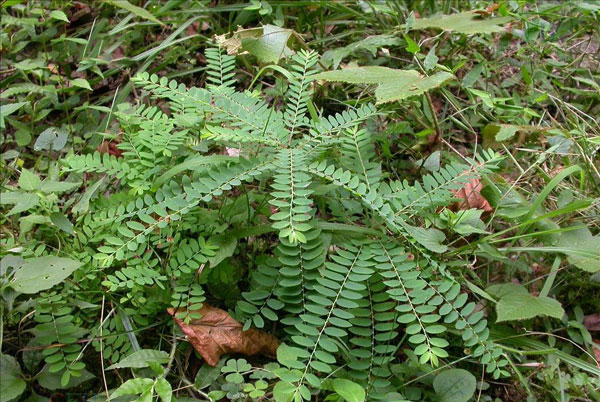
Make sure you keep a good schedule with mowing, watering and feeding your turf so it is healthy and nutrient-rich, making it better equipped to choke out any invasive weeds that want to establish themselves.
Pre-emergent applications of Isoxaben in the spring can help to keep Chamberbitter from making a return and also mulching can help. As long as you are persistent in your efforts to keep Chamberbitter from coming back.
Chamberbitter IdentificationChamberbitter Spread LocationWhy it is difficult to control ChamberbitterHow to Control ChamberbitterChamberbitter Chemical Control in LawnsControl in Landscape BedsHow to Prevent ChamberbitterChamberbitter FAQIs Chamberbitter Poisonous?Is Chamberbitter Edible? Does Chamberbitter Die in Winter?
Chamberbitter Identification
Before you can proceed with control of Chamberbitter, you need to make sure that is the weed you are dealing with. Misidentifying a weed can lead to using the wrong herbicide which may be ineffective in treating it, costing you time and money. Here are the traits of chamberbitter to look for to properly identify it.Chamberbitter looks very similar to the leaves of a mimosa tree and is a member of the spurge family. It goes to seed when it is only about an inch tall and the seeds are actually little balls that develop on the underside of the leaves.
Chamberbitter is a slender shrub with alternate leaves that are oblong to almost linear.
The stems often branch and can be reddish colored. When they have matured, Chamberbitter can develop a deep taproot which makes this weed particularly difficult to completely remove without the help of chemicals.
Use the above description and image to help you in properly identifying carpetweed. If you are having trouble, you can always contact us and our lawn care experts will help to correctly ID your weed growth and suggest treatment options.

Chamberbitter Spread Location
You'll also come to know why it invaded your garden/lawn in the first place and how severe the infestation is. It usually appears in warm conditions, i.e., May or June. You’ll most probably find them in Ornamental beds and turfgrass. This broadleaf weed can also be found growing in fields, lawns, gardens, nurseries and disturbed areas. Chamberbitter thrives in much of the southeastern United States. Chamberbitter grows upright and develops strong taproot system overtime.
Why it is difficult to control Chamberbitter
What makes Chamberbitter so difficult to control is multifaceted. First it is a very tough plant that grows fast, is drought tolerant, will flower and produce seed in just two weeks and the amount of seed it produces is abundant. Moreover, when the seed capsules explode they hurl seed in many directions away from the plant thus allowing it to spread over a larger area. Also, many of the more common pre-emergent herbicides we use in the spring are not effective on Chamberbitter and since it needs very warm soil to germinate, most of the early spring applications of pre-emergents are ineffective once May rolls around and Chamberbitter is germinating.
How to Control Chamberbitter
Chamberbitter Chemical Control in Lawns
- Preemergence Herbicides
Atrazine is effective for preemergence control of chamberbitter in centipedegrass and in St. Augustinegrass lawns. Be careful not to apply on turf during the transition period from dormancy to active growth (spring green-up). Because chamberbitter tends to germinate in late spring and early summer (once the soil temperature reaches 70 °F), applications after grasses fully green up are effective. Target areas where chamberbitter was observed the previous season and be careful to not apply near the roots of desirable landscape plants.
Isoxaben is a preemergence herbicide that is effective for chamberbitter control in tall fescue, centipedegrass, St. Augustinegrass, bermudagrass, and zoysiagrass lawns. For home lawn use, it is purchased in a granular form, and the granules must be watered-in to allow the isoxaben to coat the soil surface for weed prevention. Make the first application in late spring and the second about 8 weeks later. See Table 1 for examples of products.
Isoxaben is also available as an additional active ingredient in one Bayer Advanced brand three-way herbicide. With this product, the postemergence, three-way, broadleaf weed control portion controls existing chamberbitter plants. The isoxaben portion will aid in preventing reinfestation of the area from seeds that may be present. To prevent new seeds from growing, the entire area to be protected must be sprayed. Wait 2 days after spray application and activate the isoxaben residual barrier by watering the lawn with ¼ to ½ inch of irrigation. Do not seed or overseed within 60 days after application. Do not apply isoxaben to a newly seeded lawn until it has been mowed 3 times.
- Postemergence Herbicides
On tall fescue, bermudagrass, and zoysiagrass lawns, repeat applications of three-way herbicides that contain 2,4-D, mecoprop (MCPP), and dicamba can be used to control chamberbitter. Apply these herbicides in late spring or early summer when the weeds are still young and space second application at 30 days later. These three-way herbicides may also be used on centipedegrass and St. Augustinegrass lawns at reduced rates and after the grasses have completely greened-up in the spring. Read the product labels for rates to mix and apply.
Celsius WG Herbicide, which contains thiencarbazone, iodosulfuron, and dicamba, will control chamberbitter, especially if applied when the average daily temperatures are over 60° F. Apply when chamberbitter is actively growing and again 2 to 4 weeks later, if needed. The addition of a non-ionic surfactant, such as Southern Ag Surfactant for Herbicides, will increase control.

Control in Landscape Beds
- Postemergence Herbicides
Glyphosate is a non-selective herbicide which can potentially damage any plant through contact with foliage or bark. Protect desirable plants from drift by not spraying in windy conditions, by keeping the spray nozzle close to the ground, and by using low pressure. Further protection is provided by attaching a plastic, cone shaped shield that surrounds the spray nozzle and confines the spray to the targeted plants. Shields can be made from bottomless two- liter drink bottles. Plants can also be shielded by covering with cardboard or something similar that is disposable.
When herbicides are applied to beds intended for future planting of ornamentals, care must be taken as various herbicides may injure the plants to be installed. For planned beds, glyphosate has far less soil activity (a few days) as compared with the three-way herbicides (a few weeks). Glyphosate is the safest choice for spray application in existing flower and shrub beds, so long as care is taken to prevent drift to non-target plants. Glyphosate applications are much less apt to move through the soil, be absorbed by roots, and injure existing woody ornamental shrubs.
- Preemergence Herbicides

How to Prevent Chamberbitter
After you have eliminated the Chamberbitter, you don't want it to come back. Chamberbitter requires a combination of mechanical, cultural and chemical methods to get rid of the weed and keep it away.Make sure you keep a good schedule with mowing, watering and feeding your turf so it is healthy and nutrient-rich, making it better equipped to choke out any invasive weeds that want to establish themselves.
Pre-emergent applications of Isoxaben in the spring can help to keep Chamberbitter from making a return and also mulching can help. As long as you are persistent in your efforts to keep Chamberbitter from coming back.
Chamberbitter FAQ
Is Chamberbitter Poisonous?
Chamberbitter weed isn't actually poisonous. It has medicinal value. Some people eat it as it doesn't release white milky sap as other spurges do.Is Chamberbitter Edible?
There is no such thing as 'once and done' with Chamberbitter. If we could just figure out how to make chamberbitter edible and appetizing, we could solve world hunger. They did it with Soylent Green. Actually, Chamberbitter isn't toxic, and could be used as a vegetable or in salads.Does Chamberbitter Die in Winter?
As an annual weed, chamberbitter germinates from seed, produces seed and dies all in one season. For pre-emergent control, Atrazine can be applied to St. Augustine and centipedegrass lawns in late spring after green-up since chamberbitter is a summer annual.Latest Updated
- Benefits of Bugleweed - 7 Science-backed Health Benefits
- Bugleweed Dangers & Side Effects - Is It Poisonous?
- How to Plant Evergreen Trees - What You Should Know
- When to Plant Evergreens - Grow Guide for Evergreen Trees
- 12 Wonderful Evergreen Shrubs for Your Garden
- 12 Popular Evergreen Plants with Pictures for Beginners
- When And How To Prune A Lilac Bush Like a Pro
- How to Grow & Care for Lilac Vine (Hardenbergia Violacea)
- Japanese Lilac Tree (Syringa Reticulata) Care & Propagation Guide
- Shumard Oak Pros and Cons - What to Know
Popular Articles
- Winter maintenance of Antirrhinum Majus
- How to Grow Terminalia Mantaly Tree
- How to Grow and Care for Crossostephium Chinense
- How to grow Antirrhinum Majus in spring
- Peristeria Elata (Dove Orchid) Profile: Info & Care Guide
- Underwatered Snake Plant (Sansevieria Trifasciata) - Signs And How To Fix
- How to Care for Brazilian Jasmine Plant (Mandevilla Sanderi)
- How to Grow & Care for Graptopetalum Purple Delight in Summer
- Rosa Chinensis (China Rose): Plant Growing & Care Tips
- How to Care for Baby Sun Rose (Aptenia Cordifolia)